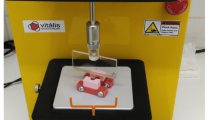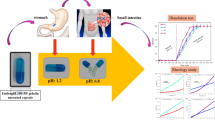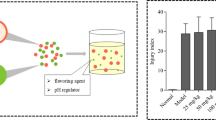Abstract
Gelatin capsules are a widely used dosage form both for pharmaceutical drug products as well as dietary supplements. Gelatin in the presence of certain compounds, mainly aldehydes, or in high humidity and high temperature conditions can cross-link. Cross-linking involves covalent bonding of the amine group of a lysine side chain of one gelatin molecule to a similar amine group on another molecule. The covalent bonding is, for practical purposes, irreversible. Cross-linking results in the formation of a pellicle on the internal or external surface of the gelatin capsule shell that prevents the capsule fill from being released. In vitro dissolution testing of cross-linked gelatin capsules can result in slower release of the drug or no release at all. The data obtained by the Gelatin Capsule Working Group, created in the early 90s to investigate noncompliance of gelatin capsules, was used to establish the type and amounts of enzymes that can be added to the dissolution medium in the case of test failure to the presence of cross-linking in the gelatin. The two-tier dissolution testing was included in the US Pharmacopeia and it recommends the addition of pepsin (pH below 6.8) or pancreatin (pH above 6.8) to the medium depending on its pH. Pepsin shows good protease activity up to pH 4 and pancreatin above pH 6 leaving a gap where neither one has good activity. Possible proteolytic enzymes that could be used for the pH range 4–6.8 could be papain or bromelain.





Similar content being viewed by others
References
Marques MRC, Cole E, Kruep D, Gray V, Murachanian D, Brown WE, et al. Liquid-filled gelatin capsules. Pharm Forum. 2009;35(4). www.usppf.com.
Podczeck F, Jones BE. Pharmaceutical capsules. London: Pharmaceutical Press; 2004.
Hu J, Kyad A, Ku V, Zhou P, Cauchon N. A comparison of dissolution testing on lipid soft gelatin capsules using USP apparatus 2 and apparatus 4. Dissol Technol. 2005;12(2):6–9.
Meyer MC, Strughn AB, Mhatre RM, Hussain A, Sha VP, Bottom CB, et al. The effect of gelatin cross-linking on the bioequivalence of hard and soft gelatin acetaminophen capsules. Pharm Res. 2000;17(8):962–6.
Chang CK, Alvarez-Nunez FA, Rinella Jr JV, Magnusson LE, Sued K. Roller compaction, granulation and capsule product dissolution of drug formulations containing a lactose or mannitol filler, starch, and talc. AAPS PharmSciTech. 2008;9(2):597–604.
Elmeshad AN, Darwish MK. Stability studies of the effect of crosslinking on hydrochlorothiazide release. Drug Discov Ther. 2009;3(3):136–42.
St. Clair MJ, Purdie J, Hu Y, McGeough P. The effect of cross-linking on the in vitro disintegration of hard gelatin capsules. J Pharm Pharmacol. 2010;62(10):1235–6.
USP. USP 36 – NF 31. <711 > Dissolution. Rockville: US Pharmacopeial Convention; 2013. p. 307.
<1094 > Capsules—dissolution testing and related quality attributes. Pharm Forum. 2013;39(3). www.usppf.com.
Cole ET, Cade D, Benameur H. Challenges and opportunities in the encapsulation of liquid and semi-solid formulations into capsules for oral administration. Adv Drug Deliv Rev. 2008;60:747–56.
Rose PI. Gelatin. In: The theory of the photographic process. 4th ed. New York: Macmillan Publ. Co.; 1977. p. 51–67.
Kalantzi L, Page R, Nicolaides E, Digenis G, Reppas C. In vitro methods can forecast the effects of intragastric residence on dosage form performance. Eur J Pharm Sci. 2008;33:445–51.
Jones BE. How gelatin and hypromellose capsules differ in product release during dissolution testing. Tablets & Capsules. 2010; January: 16–19.
Aikman M et al. Collaborative development of two-tier dissolution testing for gelatin capsules and gelatin-coated tablets using enzyme-containing media. Pharm Forum. 1998;24(5):704–7050.
USP. USP 24 – NF 19, First supplement. <711 > Dissolution. Rockville: US Pharmacopeial Convention; 2000. p. 2696
Singh S, Rao KVR, Venugopal K, Manikandan R. Alteration in dissolution characteristics of gelatin-containing formulations. Pharm Technol. 2002;26:36–58.
Tengroth C, Gasslander U, Anderson FO, Jacobsson SP. Cross-linking of gelatin capsules with formaldehyde and other aldehydes: an FTIR spectroscopy study. Pharm Dev Technol. 2005;10:405–12.
Song X, Cui Y, Xie M. Gelatin capsule shell cross-linking. Tier II dissolution method development in the presence of sodium lauryl sulfate. Pharm Technol. 2011;35(5):62–8.
Piper DW, Fenton BH. pH stability and activity curves of pepsin with special reference to their clinical importance. Gut. 1965;6:506–8.
USP. USP 36 – NF 31. Purified pepsin. Rockville: US Pharmacopeial Convention; 2013. p. 1181.
Kristo K, Pintye-Hodi K. Effects of pharmaceutical processing on pepsin activity during the formulation of solid dosage forms. Pharm Dev Technol. 2013;18(1):17–21.
Berdutina AV, Neklyudov AD, Ivankin AI, Karpo BS, Mitaleva SI. Comparison of proteolytic activities of the enzyme complex from mammalian pancreas and pancreatin. Appl Biochem Microbiol. 2000;36:363–7.
USP. USP 36 – NF 31. Pancreatin. Rockville: US Pharmacopeial Convention; 2013. p. 4672.
Azarkan M, El Moussaoui A, van Wuytswinkel D, Dehon G, Looze Y. Fractionation and purification of the enzymes stored in the latex of Carica papaya. J Chromatogr B Analyt Technol Biomed Life Sci. 2003;790(1–2):229–38.
Arnon R. Papain. In: Perlmann G, Lorand L, editors. Method in enzymology, vol. 19. New York: Academic; 1970. p. 226–45.
Kimmel JR, Smith EL. The properties of papain. In: Nord FF, editor. Advances in enzymology and related areas of molecular biology, vol. 19. New York: Interscience Publ; 1957. p. 267–333.
Lineweaver H, Schwimmer S. Some properties of crystalline papain. Enzymologia. 1941;10:81–6.
Hoover SR, Kokes ELC. Effect of pH upon proteolysis by papain. J Biol Chem. 1947;167(1):199–207.
USP. USP 36 – NF 31. Papain. Rockville: US Pharmacopeial Convention; 2013. p. 4186.
Corzo CA, Waliszewski KN, Welti-Chanes J. Pineapple fruit bromelain affinity to different protein substrates. Food Chem. 2012;133(3):631–5.
Lu X, Xiao B, Lo L, Bolgar MS, Lloyd DK. Development of a two-step tier-2 dissolution method for blinded overencapsulated erlotinib tablets using UV fiber optic detection. J Pharm Biomed Anal. 2011;56:23–9.
Pennings FH, Kwee BLS, Vromans H. Influence of enzymes and surfactants on the disintegration behavior of cross-linked hard gelatin capsules during dissolution. Drug Dev Ind Pharm. 2006;32:33–7.
USP. USP 36 – NF 31. The dissolution procedure: development and validation <1092>, Rockville: US Pharmacopeial Convention; 2013. p. 735.
Gallery J, Han JH, Abraham C. Pepsin and pancreatin performance in the dissolution of crosslinked gelatin capsules from pH 1 to 8. Pharm Forum. 2004;30(3):1084–1089. www.usppf.com.
Bottom CB, Clark M, Carstensen JT. Dissolution testing of soft shell capsules—acetaminophen and nifedipine. J Pharm Sci. 1997;86(9):1057–61.
Author information
Authors and Affiliations
Corresponding author
Additional information
Guest Editor: Susan D'Souza
Rights and permissions
About this article
Cite this article
Marques, M.R.C. Enzymes in the Dissolution Testing of Gelatin Capsules. AAPS PharmSciTech 15, 1410–1416 (2014). https://doi.org/10.1208/s12249-014-0162-3
Received:
Accepted:
Published:
Issue Date:
DOI: https://doi.org/10.1208/s12249-014-0162-3




